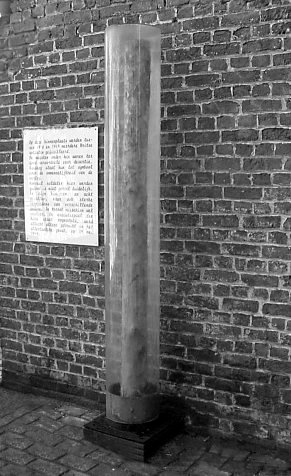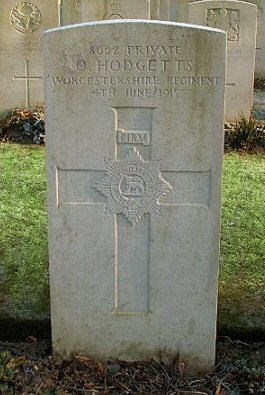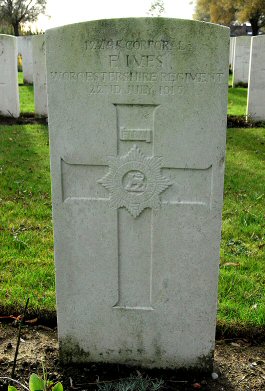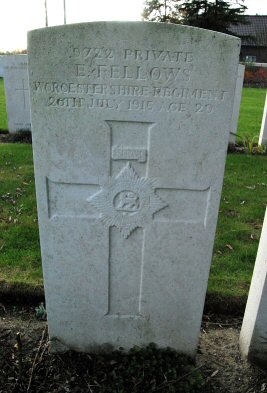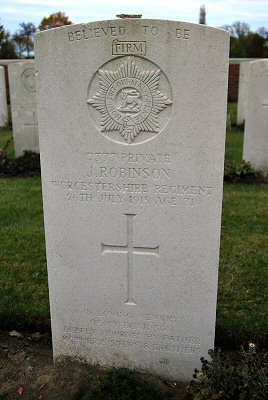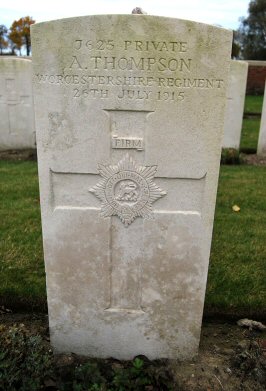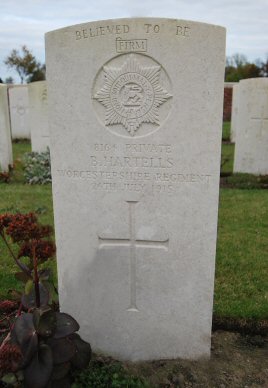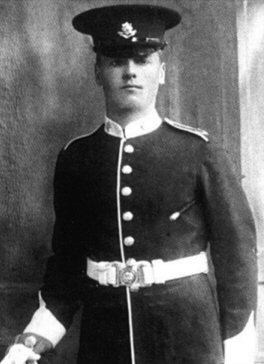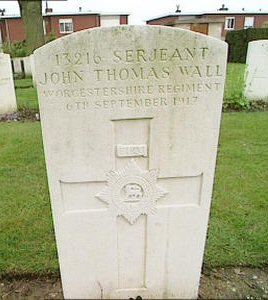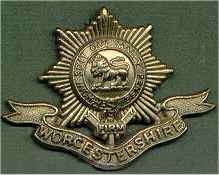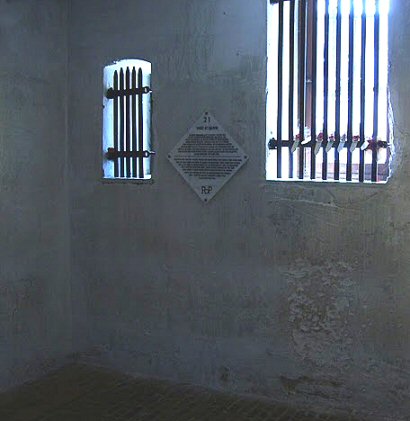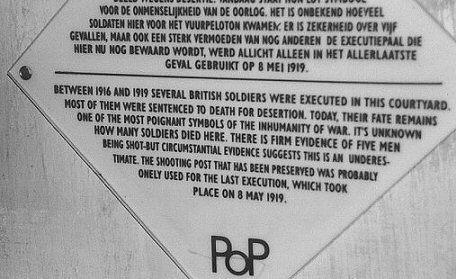Shot at Dawn
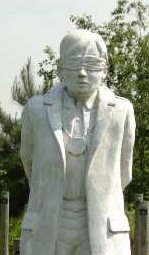 During the First World War there were 346 Military executions (this figure includes Commonwealth Troops) by firing squad. Soldiers' executions served a dual purpose, to punish the deserters and to dispel similar ideas in their fellow soldiers'.
During the First World War there were 346 Military executions (this figure includes Commonwealth Troops) by firing squad. Soldiers' executions served a dual purpose, to punish the deserters and to dispel similar ideas in their fellow soldiers'.
Offences under the British Army Act, which resulting in a court martial with a sentence to be shot at dawn included alleged acts of cowardice, desertion, sleeping at post, casting away arms and disobedience.
Those condemned to death usually had their sentences confirmed by Field Marshal Sir Douglas Haig on the evening following their court-martial. On the evening before the execution a chaplain would be dispatched to spend the night in the cell with the condemned man. The next morning, at dawn, the execution would take place. Prior to the execution many of the condemned men sometimes drugged with morphia or alcohol.
The firing squad which was usually composed of at least six soldiers. One of their rifles was customarily loaded with a blank round and no soldier could be sure he had fired a fatal shot.
The offender was tied to a stake and a medical officer would step forward and pin a piece of white cloth over the man's heart, the priest would then say a pray. After they had both withdrawn, the order was given to fire. Immediately the shots had been fired the medical officer would examine the man, if he was still alive, the officer in charge would have to finish him off with a revolver.
Execution Post at Poperinge |
It is recognised today that many of the soldiers who were shot may have been suffered from "shell shock" or "battle fatigue" and were obviously under extreme stress, which resulted in them deserting or other actions. Today these conditions are better known as Post-Traumatic Stress Disorder, which is recognised as an illness. Non of the executed soldiers would be shot today, the military death penalty was finally outlawed in 1930. Many of these men proved they were brave by refusing to be blindfolded for their executions. They stared down the barrels of the guns which were about to kill them. That's not cowardice. That's courage. Britain was not alone in executing its own soldiers during the First World War. The French are thought to have killed about 600 soldiers. The Germans, whose troops outnumbered the British by two to one, shot 48 of their own men, and the Belgians shot 13. However, not one American or Australian soldier was ever executed. In 2001, 23 executed Canadians were posthumously honoured by their government, and five soldiers killed by New Zealand's military command also recently won a pardon. At Poperinge New Military cemetery (12 Km west of Ieper, Belgium) there is a record detailing the largest number of men to be executed by the British Army and buried in one place. The reason for this lies in the fact that such disciplinary matters were usually carried out when the battalions were in camp away from the front lines and Poperinge was one of the most important centres for military camps in the British sector. Worcestershire Regiment menDuring the First World War there were 8 soldiers of the Worcestershire Regiment that were shot by firing squad. On the 26th July 1915 five men of the 3rd Battalion Worcestershire Regiment were executed on the ramparts of Ypres in what became the largest single execution by the British during the war. They were originally buried in the Ramparts Cemetery, they were later transferred to other cemeteries in the area. Details of all Worcestershire Regiment men is shown below:
|
Private Oliver William Hodgetts (8662) 1st Battalion Worcestershire RegimentHe was serving with the 1st Battalion when they arrived in Western Front on the 8th November 1914 fresh from Egypt. Some 5 days later the Battalion took up a defensive position in trenches facing Neuve Chapelle and came under heavy bombardment from the enemy during which 7 men were killed and 25 wounded. During the next 3 days (16th to 19th November 1914) a further 13 men were killed and 27 wounded. During this period Private Hodgetts went missing but on this occasion no action was taken against him. On the 19th November 1914 the men of the 1st Battalion exhausted climbed out of the trenches frozen and in heavy snow fall made their way back to billets at La Gorgue, six miles away. Next day one man in four suffered with frost-bitten hands or feet and in many cases feet or toes had to be amputated. On the 9th May 1915 just prior to the attack on Festubert, Hodgetts went missing yet again just as the Battalion prepared to go into action. On the 12th May he reported to a nearby unit and claimed he had sprained his ankle, but when he was examined by the medical officer no injury was discovered. On the 22nd May 1915 he was brought to trial where he was undefended. Hodgetts conduct sheet showed that he had been sentenced to 90 days field punishment on the 1st March 1915. His commanding officer Major George W. St. G. Grogan at the trial described Hodgetts as a worthless fighting soldier who was only intent on saving his own skin. At his court martial Private Hodgetts was found guilty of cowardice. Field Marshal Sir John French confirmed the sentence and Private Hodgetts was shot by firing squad on the 4th June 1915. He was only 20 years of age. He is buried at Royal Irish Rifles Graveyard, Laventie, Pas de Calais, France (Grave number IV.D.2).
|
Private Oliver William Hodgetts (8662)
|
Corporal Frederick Ives (12295) 3rd Battalion Worcestershire RegimentCorporal Ives had only been in France just over a month when on the 15th September 1914 he went absent without permission during the fighting on the Marne. He was already on remand for an earlier offence. Ives managed to avoid capture for 9 months. He was eventually arrested on the 24th June 1915 by an officer of the Army Veterinary Corps. At the time he was wearing civilian clothes. Ives court martial took place on the 7th July 1915, and in his defence he stated that he had suffered memory loss due to shell fire. Although he was found guilty of desertion and sentenced to death, the members of the court martial recommended mercy on the grounds that he might be telling the truth. However, his sentence of death was confirmed by the Field Marshal and he was shot by firing squad with 4 other deserters from the 3rd Battalion on the ramparts of Ypres on the 26th July 1915. He was 30 years of age. He was originally buried at the Ramparts Cemetery but was later transferred to the Perth Cemetery (China Wall), Belgium which is 3 Km east of Ypres town centre (Grave number I.G.41). For some strange reason the Commonwealths War Graves Commission shows the date of death incorrectly as the 22nd July 1915. This error may have been made as he was tried and sentenced week before the other men of the 3rd Battalion who were executed the same day. |
Corporal Frederick Ives (12295)
|
Private Ernest Fellows (9722) 3rd Battalion Worcestershire RegimentPrivate Fellows of Birmingham was a married man with children. At the start of the First World War Ernest Fellows as an ex Worcestershire Regiment soldier was on the Reserve List and as such was called up for service in September 1914. He re-joined his Regiment on the 29th September 1914. Fellows was sent to France as part of reinforcements for the 3rd Battalion Worcestershire Regiment early in 1915. Private Fellows was a well respected soldier in the Battalion and he had past experience. Early in June 1915 the 3rd Battalion was holding a line of trenches from the Menin Road on the left to Sanctuary Wood on the right. After 4 days of fighting, on the 9th June 1915 the 3rd Battalion was relieved by the 2nd Royal Irish Rifles. The 3rd Battalion then moved out of the line to Busseboom just east of Poperinghe where they were billeted in bivouac and rested until the 15th June 1915. It was during this rest period that Private Fellows went missing without permission. Following an evening roll call it was discovered that he had gone absent. The Battalion had just received orders that it was to attack enemy trenches at Bellewaerde the following day. Fellows was apprehended and was tried at a court martial on the 14th July 1915. At his trial he offered no evidence in his defence and was found guilty of desertion and sentenced to death. Fellows was shot by firing squad with 4 other deserters from the 3rd Battalion on the ramparts of Ypres on the 26th July 1915. He was 29 years of age. He was originally buried at the Ramparts Cemetery but was later transferred to the Perth Cemetery (China Wall), Belgium which is 3 Km east of Ypres town centre (Grave number V.K.13).
|
Private Ernest Fellows (9722) |
Private John Robinson (7377) 3rd Battalion Worcestershire RegimentPrivate Robinson of Nechells, Birmingham was a regular soldier with 13 years previous service and had been with the 3rd Battalion since Mons in August 1914. On the 27th June 1915, Private Robinson and Private Alfred Thompson absconded together after they were told that they were to be on night duty in trenches near Hooge. The 3rd Battalion had been in action in this area since 16th June. On the 5th July 1915 both Private Robinson and Private Thompson were arrested at Abancourt while they were sitting on a train bound for Rouen. At their court martial in a statement it said that both men were good soldiers, but that it appeared they were suffering from nervous strain at the time they went absent. Robinson was shot by firing squad with 4 other deserters from the 3rd Battalion on the ramparts of Ypres on the 26th July 1915. He was 31 years of age. He was originally buried at the Ramparts Cemetery but was later transferred to the Aeroplane Cemetery, Belgium, which is 3.5 Km northeast of Ypres town centre (Grave number II.A.6/7). the grave of Robinson has the following inscription: "In loving memory of my dear son deeply mourned by father mother, sisters and brothers".
|
Private John Robinson (7377)
|
Private Alfred Thompson (7625) 3rd Battalion Worcestershire RegimentPrivate Thompson of Holloway Head, Birmingham was a regular soldier. He had joined the Battalion at the beginning of November 1914. On the 27th June 1915, Private Alfred Thompson and Private Robinson (see above) absconded together after they were told that they were to be on night duty in trenches near Hooge. The 3rd Battalion had been in action in this area since 16th June. On the 5th July 1915 both Private Thompson and Private Robinson were arrested at Abancourt while they were sitting on a train bound for Rouen. However, this did not effect the outcome of the trial. Thompson was shot by firing squad with 4 other deserters from the 3rd Battalion on the ramparts of Ypres on the 26th July 1915. He was 25 years of age. At their court martial in a statement it said that both men were good soldiers, but that it appeared they were suffering from nervous strain at the time they went absent. He was originally buried at the Ramparts Cemetery but was later transferred to the Aeroplane Cemetery, Belgium, which is 3.5 Km northeast of Ypres town centre (Grave number II.A.8).
|
Private Alfred Thompson (7625)
|
Private Bert Hartells (8164) 3rd Battalion Worcestershire RegimentPrivate Hartnells was a farm labourer from Rowney Green, Alveschurch near Redditch. He joined the army a few months before his 21st birthday, enlisting on the 27th January 1904 at Worcester and joined the 1st Battalion Worcestershire Regiment. He served with the 1st Battalion at Templemore, Ireland. In November 1904 he was posted to the 2nd Battalion and joined them at Columbo, Ceylon and later move to the camp at Diyatalawa. In December 1906 he sail with the 2nd Battalion, on s.s. Soudan, to India disembarking at Bombay on the 19th December 1906. The battalion then made their way to Ahmednagar arriving on the 21st December 1906. In January 1912 he transferred to the 1st Class Army Reserves . He was mobilised at the start of the war in August 1914 and posted to the 3rd Battalion Worcestershire Regiment and landed in France with the the 3rd Battalion on the 12th August 1914. On the 25th November 1914 he went absent without permission, he was absent for 71 days. On the 4th February 1915 he was charged awaiting General Court Marshal. On the 24th February 1915 he was sentenced to 1 year imprisonment hard labour, but this was commuted to 3 months in March 1915. Shortly after his release in June 1915 he went absent again on the 15th June 1915, but this time he was listed as a deserter. He was recaptured and again tried by General Court Mashal and this time he was found guilty of desertion and sentenced to be shot. Hartnells was shot by firing squad with 4 other deserters from the 3rd Battalion on the ramparts of Ypres on the 26th July 1915 at 4.0 a.m. in the morning. He was 32 years of age. After his death his personal effects which include a knife, pipe, 2 photos and a letter were sent to his father William Hartells. The common law wife of Private Bert Hartells also contacted the Ministry of Pensions stating she was living as the wife of Private Hartells for the past 4 years and that they had two little boys age 3 and 2. She also stated that they had failed to formalise the marriage. When war was declared they published the bands for marriage but that as he had no leave so that they could not put the matter right. She was finally awarded a pension in May 1918. He was originally buried at the Ramparts Cemetery but was later transferred to the Aeroplane Cemetery, Belgium which is 3.5 Km northeast of Ypres town centre (Grave number II.A.6/7).
|
Private Bert Hartells (8164)
|
Sergeant John Thomas Wall (13216) 3rd Battalion Worcestershire RegimentSergeant J. T. Wall of Bockleton, near Tenbury, Worcestershire had enlisted in the Worcestershire Regiment in 1912. He was posted to the 1st Battalion Worcestershire Regiment and after thirteen months' he was transferred to the 3 Battalion Worcestershire Regiment. He landed as a Lance-Corporal with the 3rd Battalion on the 12th August 1914. He had fought with his Battalion in every engagement. By 1917 his combat record, exemplary discipline and very good character had secured Wall promotion to sergeant. In August 1917 the 3rd Battalion, was directed to assault Westhoek Ridge. On the evening of Thursday, 9th August the 3rd Battalion moved up from Halifax Camp to Bellewaerde Ridge. Two companies went into trenches immediately behind the crest of the Ridge, the remaining two companies, including Wall's, relieved the 8th Border Regiment at Lake Farm and Railway Wood Dugouts. At 2 a.m. on 10th August Company Sergeant Major J. Davies told his platoon sergeants, including Wall, to order their men to move out from Railway Wood Dugouts. Weighed down with rifles, buckets of grenades, digging implements and wire-cutters, the platoons, at 200-yard intervals, made their way towards the assembly positions. Plodding through gas-polluted mud, Wall's company was inching over Bellewarde Ridge when the leading platoon lost its way in the darkness. The British bombardment erupted. Two minutes later German heavy guns retaliated, targeting the reinforcements assembled behind the advancing troops. Caught on the exposed crest of the Ridge, Wall's platoon column was raked by storm of enemy shellfire. Lieut. Thomas Randle ordered the platoon to take cover and nine men, including Wall, huddled into a nearby concrete dugout. Others cowered outside, partially protected by the emplacement's bulky exterior. After a while Sergeant Davies, taking advantage of breaks in the bombardment, detached small parties of the more exposed group and sent them on their way up the line. |
Sergeant John Thomas Wall (13216) |
Amongst those who squeezed into the dugout was Pte. W. H. White, who later testified for the prosecution at Wall's trial. White recalled that after hearing a summons from outside, six of the men in the dugout departed, leaving himself, Wall and Pte. Rowlands. After the shelling had abated Wall and White emerged from the dugout, searched vainly for the rest of the Company and concluded that they had gone back to Railway Wood Dugouts. He added "Just then the enemy got up their barrage and so we remained in the dugout. We stayed there all that day and through the next day, the 11th August, up till about 5 or 6 p.m. when the shelling had ceased." Wall, White and Rowlands then returned to the Railway Wood Dugouts and remained there until the Company returned on the morning of 12th August, when the sergeant reported himself present to the duty sergeant. On being asked where he had been, Wall explained that he had reported what had happened to an officer from another regiment. |
|
Wall was subsequently charged with desertion and tried by Field General Court Martial on 20th August. He was undefended but gave sworn testimony about his conduct. He said: "As far as I knew the Company was going up in the supports for an attack. On the way we lost direction and halted. The enemy opened fire and our officer ordered us, 'to take cover'. I looked round for cover from my platoon. I did not find any place except a concrete dugout in which I found 9 or 10 men and I joined them there, the rest of the company was sheltering around the dugout and in an old piece of trench. I stopped in the dugout. Whilst there Sergeant Barlow of my company came in and said 'he wanted 4 to 6 men to go on a patrol'. He got his men from the dugout, leaving only Rowlands, White and I there. About 5 minutes later I went outside to see what the company was doing, or to get some men into the dugout, but I found that the company had gone." The Court Martial did not take into account Wall's impeccable military career or the full extent of the circumstances at the time. However, Sergeant Wall was found guilty and sentenced to be shot. The officer who authorised Wall's court-martial was a celebrated Hampshire cricketer, Lieut.-Colonel Alexander Johnston, who had formerly commanded 10 Battalion Cheshire Regiment, also part of 7th Brigade. He had taken over from Brigadier General Cranley Onslow barely twenty-four hours before Wall's platoon set out for Bellewaerde Ridge. Sergeant Wall (age 22) was executed at 5.25 a.m. on 6th September 1917 at Poperinghe by a firing squad under the command of Captain Alfred Vint, 3 Battalion Worcestershire Regiment. Commenting in his diary, a fellow officer of Vint's confided: "6th September 1917. Dickebusch... Sergt. Wall 'B' Coy, shot by order of F.G.C.M. for cowardice in the face of the enemy. The sentence was carried out by a section found from all companies of this battalion; which is unusual, as hitherto firing parties have been found from another Battn. to that of the prisoner. To me, it seems a miscarriage of justice, as Wall had been out in France since August 1914, and had fought in many battles, and was probably quite mad at the time of his offence. One cannot go through three years of this inferno and keep sane in all circumstances."
|
Sergeant John Thomas Wall grave Sergeant Wall is buried at Poperinghe New Military Cemetery. Poperinghe New Military Cemetery is located 10.5 km west of Ypres town centre, in the town of Poperinghe itself (Grave number II.F.42). His parents William and Harriet Wall place the following inscription on his gravestone: "For ever with the Lord". |
Private Robert Young (204232) 11th Battalion Worcestershire RegimentPrivate Young was already serving under a two year suspended sentence for absence and striking a superior officer, when he went missing again. This offence had been committed just two months before the end of hostilities, when Private Young found himself in action for the first time. During heavy shelling in which the dugout had been blown in, Young made his way to the rear. Although at his court martial he was convicted of desertion, had evidence been available at the time a charge of cowardice might have been preferred. At his trial little or no regard was paid to statements made by him in defence of his actions and he was executed by firing squad on the 18th September 1918. He was 21 years of age. Private Young is buried at the Karasouli Military Cemetery, Greece. The cemetery is near the town of Polikastron (formerly Karasouli) which lies some 56 Km from Thessalonika (Grave number D.885.).
|
|
Inside the execution cell Poperinge, Belgium |
Final Justice for all the men Shot at DawnIn August 2006, Des Browne, the Defence Secretary at the time decided to cut short a review that had been prompted by campaigns to exonerate the men who had been executed, and emergency legislation was put to the House of Commons later that year. All 306 soldiers of the First World War who were shot at dawn for cowardice or desertion would be granted posthumous pardons.
|

